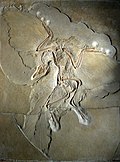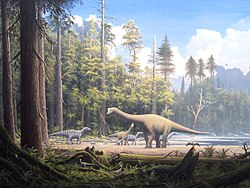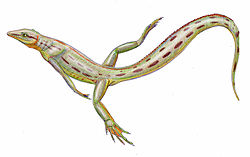Sauropsid
Sauropsids are a group of land vertebrates which includes all existing reptiles and birds and their fossil ancestors.
| Sauropsids Temporal range: Pennsylvanian – Recent
| |
|---|---|
| Scientific classification | |
| Kingdom: | |
| Phylum: | |
| Subphylum: | |
| Superclass: | |
| (unranked): | |
| (unranked): | Sauropsida
|
They are one of the two groups which evolved from egg-laying amniotes in the first part of the Carboniferous period.[1][2][3]
The synapsids are the other group which evolved from amniotes. They gave rise, eventually, to the mammals.
Living sauropsids include lizards, snakes, turtles, crocodiles, and birds. Extinct sauropsids include non-avian dinosaurs, pterosaurs, plesiosaurs, ichthyosaurs, and many others.
Origin of tetrapods
More or less, the evolution of tetrapods has taken this course:
The earlies tetrapods lived in water.[4] Clear fossil tetrapod tracks from the mid-Devonian predate previous tetrapod records by 18 million years.[5]
Nine genera of Devonian tetrapods have been described. These earliest tetrapods were not terrestrial. They lived in swampy habitats like shallow wetlands, coastal lagoons, brackish river deltas, and even shallow marine sediments.
Romer's gap
Between the lobe-finned fish tetrapods and the first amphibia and amniotes in the Middle Carboniferous lies a gap of 30 million years, with few satisfactory tetrapod fossils. This is "Romer's gap".[6] Some new fossils were found in the 1990s, such as Pederpes, right in the middle of the Romer Gap. The gap still obscures the details of the tetrapod transition.
Sometime, in the later Devonian or earliest Carboniferous, the fishapods became mainly land-based. One group of them kept their link to the water, and always laid their eggs in water. They became the amphibians. The others evolved a way of laying eggs on land. They were the amniotes, whose key innovation was the cleidoic egg.
Sometime in the middle or lower Carboniferous, the amniotes split into two lines. One line lead to the reptiles of all kinds, and we call that the Sauropsida. The other line led eventually to the mammals, and we call that the Synapsida. It is not right to say "mammals evolved from reptiles" because both groups derived from early amniotes. In any event, modern reptiles are vastly different from modern mammals.[7] Both groups have evolved for over 300 million years from the early amniotes.
Tetrapods
Sauropsid Media
The Berlin specimen of Archaeopteryx lithographica, a historically important fossil which helped to establish birds as a component of the reptile family tree
Mesozoic sauropsids: non-avialandinosaurs (Europasaurus and iguanodonts) alongside the early bird Archaeopteryx perched on the foreground tree stump.
References
- ↑ Gauthier J.A; Kluge A.G & Rowe T. 1988. The early evolution of the Amniota. pp103–155 in Michael J. Benton (ed) The phylogeny and classification of the tetrapods, Volume 1: Amphibians, Reptiles, Birds. Systematics Association, Special vol 35A. Clarendon Press, Oxford.
- ↑ Gauthier J.A. 1994. The diversification of the amniotes. In D.R. Prothero and R.M. Schoch (eds) Major features of vertebrate evolution. 129-159. Knoxville, Tennessee: The Paleontological Society.
- ↑ Laurin M. & Gauthier J.A. 1996. Amniota, mammals, reptiles (turtles, lizards, Sphenodon, crocodiles, birds) and their extinct relatives. Version 01 January 1996. The Tree of Life Web Project.
- ↑ Clack, Jennifer 2012. Gaining ground: the origin and early evolution of tetrapods. 2nd ed, Bloominton, Indiana: Indiana University Press. ISBN 978-0-253-35675-8, (Sauropsid at Google Books)
- ↑ Janvier, Phillipe and Clément, Gaël 2010. Muddy tetrapod origins. Nature 463, p40.
- ↑ Romer A.S. 1949. The vertebrate body. Saunders, Philadelphia. 2nd ed. 1955; 3rd ed. 1962; 4th ed. 1970
- ↑ Goodrich E.S. 1930. Studies on the structure and development of vertebrates. Macmillan, London. xxx+837p, 754 figures. One of the great works of vertebrate comparative anatomy.









